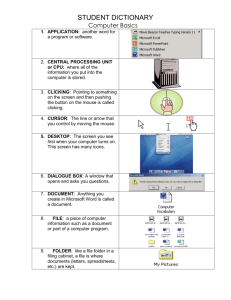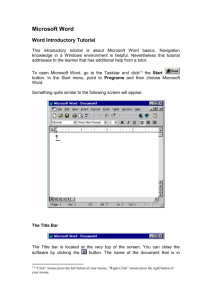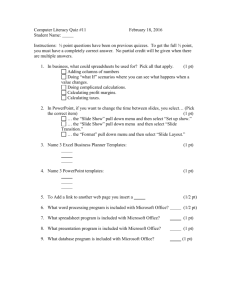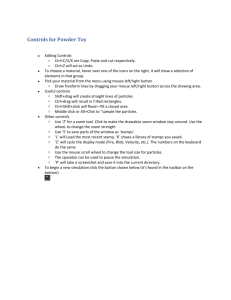How to adjust a Microsoft Windows Computer for
advertisement
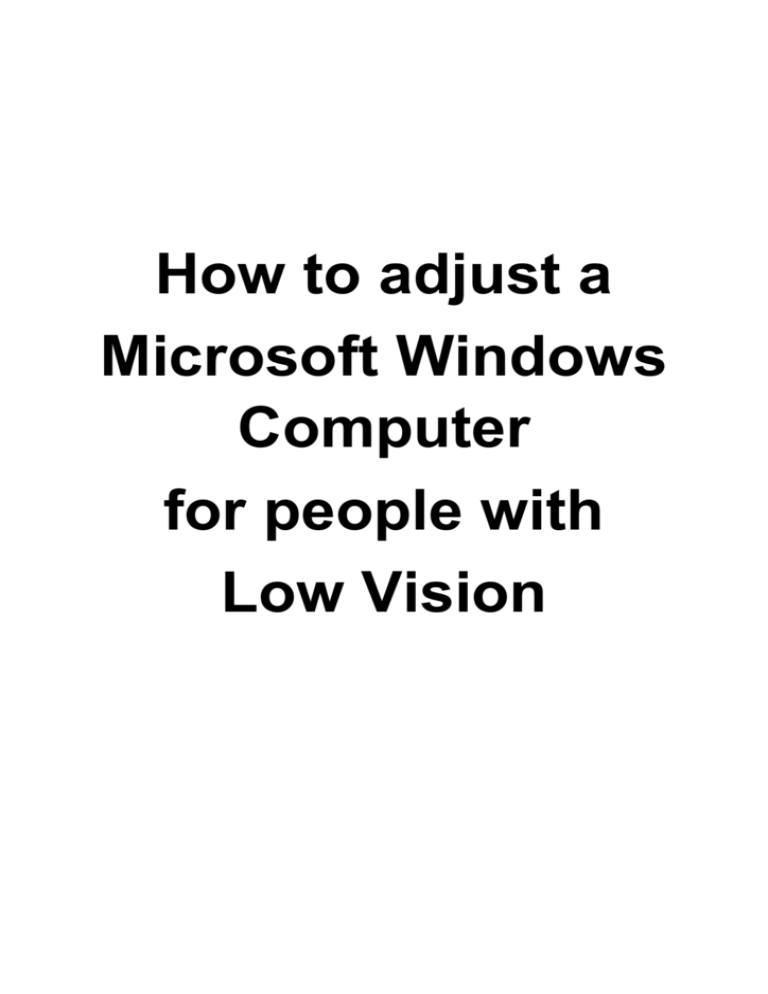
1 How to adjust a Microsoft Windows Computer for people with Low Vision Acknowledgements This document has been adapted from a publication originally produced by Vision Australia www.visionaustralia.org Thanks to Retina New Zealand for their feedback and contribution to this booklet. Produced by: New Zealand Association of Optometrists PO Box 1978 Wellington 6140 Ph: 04 473 2322 Fax: 04 473 2328 info@nzao.co.nz www.nzao.co.nz First Printed July 2008 Page 2 Introduction For people with low vision, adjusting light, size and colour contrast can help them see detail when reading and using a computer. To see detail on the computer screen, key adjustments to think about are: Brighter: Is there enough close light? Can glare be reduced for better visibility? Bigger: Can it be made bigger? Bolder: Is there enough contrast? Do objects or text on the screen stand out from the background? This booklet provides ‘no cost’ or ‘low cost’ options for using these bigger, bolder, brighter principles to see more details on a computer running Microsoft Windows operating system. Everyone’s sight varies. This booklet describes a number of different options that can assist people with low vision to use their computer. Not every option will suit every person. Try all of them and find out what best suits the individual’s needs. If a computer user still has difficulty seeing objects on the computer screen after adjusting lighting, magnification and contrast, it may be time to consider using a speech program. This booklet explains how to use a basic speech program. More advanced software programs are available. Specialists in low vision may offer some guidance on the different options to suit individual needs. Page 3 Page 4 Contents Setting up your work area.......................................................... 6 Computer keyboards ................................................................. 7 Identifying your computer’s operating system .......................... 7 Microsoft Vista ........................................................................... 8 Adjusting the computer for large print and magnifying ........... 10 Enlarging the text on Microsoft Word and Excel documents using the Zoom feature............................................................ 11 Enhancing contrast and/or enlarging text display in Microsoft Windows 95 and 98 ................................................................. 12 Enhancing contrast and/or enlarging text display in Microsoft Windows XP ............................................................................ 16 Reducing the visual clutter on the desktop .............................. 21 Adjust the cursor and mouse pointer ....................................... 32 Putting a trail on the mouse to increase visibility..................... 34 Low vision options for reading Internet pages ........................ 35 Microsoft Short Cut Keys ......................................................... 38 Using the Windows Magnifier .................................................. 40 Screen magnification software................................................. 41 Screen reading programs ........................................................ 42 Features to look for when purchasing a computer screen or monitor ..................................................................................... 43 Where to get further help ......................................................... 44 Page 5 Setting up your work area • Make yourself comfortable at the computer. Your monitor should be clean and positioned at eye level. • Use a desk or task lamp to illuminate the keyboard or any reading material you may need to use. • Close your curtains or blinds so there is no glare from your windows. You may also need to angle your screen to avoid glare from other light sources. Anti-glare screens that fit over the computer screen are available from computer suppliers. These can reduce the contrast so choose carefully. • Don’t eliminate all light in the room. You need to be able to see where you are going when you get up from the computer and walk around the room. Remember to take regular breaks from the computer to avoid eye fatigue. Page 6 Computer keyboards Keyboards designed for low vision are available or alternatively adjusting your existing keyboard with commercially available products such as ZoomCaps. These are adhesive labels for computer keys. The letters, numbers, and symbols have good colour contrast and are enlarged for easier viewing. Labels are available in black on ivory and white on black, customised for Windows or Macintosh keyboards. Refer to: www.mtc-inc.com/Products/Zoomcaps.htm Identifying your computer’s operating system You will need to identify your operating system to follow some of the tips in this booklet. Do this now for future reference. 1. Right click on the My Computer icon on your desktop. 2. Left click on Properties. The General page will tell you what system you have on your computer i.e. Windows 95 or 98 or XP. The most common systems for home computers are Windows 98, Windows XP and most new computers purchased in 2008 now have Vista. Microsoft Vista operating system looks quite different to 98 and XP. If the PC is running Vista you will find the Computer icon on your desktop (see below). Right click and follow step 2 as detailed above. Page 7 Microsoft Vista The Vista operating system has improved accessibility options. Display settings can be changed in one window called Ease of Access control centre (See the Icon on the left). Ease of Access gives you similar settings to XP and 98 but centralises all the options and provides a quick step by step process to set up features like magnifier, speech and visual display settings. (See diagram next page) To open Ease of Access: 1. Left click on Start Menu; 2. Left click on Settings. Choose Control Panel 3. Find Ease of Access Icon and double click to open. Desktop Settings: You can adjust the screen background mouse pointers and sound. Right click in any blank space in the desktop screen and select Personalize to bring up the following control centre options. Page 8 The Ease of Access and Personalize control centre panels provide direct links to similar menu options described in this booklet for Windows 98 and XP. If you are a Vista user, you can use the control centres to work through various options available to find what best suits you. Page 9 Adjusting the computer for large print and magnifying The optimum resolution for large print and magnifying is 800 x 600 pixels. You can change resolution by using the Settings tab in the Display Properties window. 1. Right click on the desktop. 2. Choose Properties from the pop-up menu. The Display Properties window will appear. 3. In the Display Properties window click on the Settings tab. 4. Change the Screen Area to 800 x 600 pixels. 5. Click Apply. Page 10 Enlarging the text on Microsoft Word and Excel documents using the Zoom feature There are two ways to use this feature. 1. Left click on the View option (“A” on the diagram below). Try different percentages and pick one that suits you. OR 2. Left click on the zoom box (“B” on the diagram below) to increase the size of a document. Try different percentages and pick one that suits you. A B Alternative method: If your computer has a mouse with a scroll wheel (Wheel Mouse), you can use the mouse to quickly zoom in or out on documents. Hold down the control key [Ctrl ] on your keyboard and turn the scroll wheel to reduce or enlarge the screen view of document. This Ctrl + wheel mouse method can be used to Zoom in or out on documents viewed in most Microsoft Office applications. Page 11 Enhancing contrast and/or enlarging text display in Microsoft Windows 95 and 98 The colours on your computer screen can be changed to enhance the contrast. The sizes of the menus, window titles, cursors, dialogue boxes and the icons can also be increased. These changes are made using the Appearance tab in the Display Properties window. 1. Right click on the desktop. 2. Choose Properties from the pop-up menu. The Display Properties window will appear (diagram overleaf). 3. Click on the Appearance tab in the Display Properties window. Then on the Appearance tab: 1. Click the arrow on the Scheme box to see a list of options. 2. As you click an option, a preview of what that colour scheme would look like appears in the window. 3. Select the scheme you want. This would usually be “High Contrast White (Large)” or “High Contrast Black (Large)” (diagram overleaf). 4. Click OK. Vista users should refer to pages 8 and 9 Page 12 If the automatic size change that occurred with the Scheme change is not large enough, increase it further by using the Item box on the Appearance tab. 1. Click the arrow on the Item box (bottom right) to see a list of options. 2. Select Active Title Bar. 3. Click the Size up arrow to increase the size of the bar. As you click, a preview of the size appears. 4. Click the Font arrow to select your preferred font, for example Arial. Page 13 5. Click the font Size up arrow to increase the size of the font. As you click, a preview of the font size appears. The same steps are used to increase the sizes of the following items contained in the Item list: Icon, Inactive Title Bar and Menu. Select these via the Item arrow following steps 1-2 above and follow steps 3-5 as required to increase the sizes and fonts on the display. Page 14 Saving your new display You can save all the changes you have made by using the Save As… command in the Appearance tab. On the Appearance tab, 1. Click on Save As… 2. Type in the name you wish to give your scheme, for example your own name. 3. Click OK. Page 15 Enhancing contrast and/or enlarging text display in Microsoft Windows XP The colours on your computer screen can be changed to enhance the contrast. The sizes of the menus, window titles, cursors, dialogue boxes and the icons can also be increased. These changes are made using the Accessibility Wizard. 1. Left click on Start. Select Programs, then Accessories, then Accessibility, then Accessibility Wizard (diagram below). 2. Select Next in the Welcome to the Accessibility Wizard dialogue box. Page 16 3. In the Text Size dialogue box, select the smallest text you can read then press Next. Remember to choose a size you are comfortable with. 4. In the Display Settings dialogue box, ensure that the Change the font size check box is selected. If it is not, click on the check box. If you want to use Microsoft Magnifier (see magnifier section in this booklet), select the Use Microsoft Magnifier check box. Select Next. 5. In the Set Wizard Options dialogue box, select the ‘I am blind or have difficulty seeing things on screen’ check box (diagram below). Select Next to continue. Page 17 6. In the Completing the Accessibility Wizard dialogue box, select Finish to save your changes and exit the wizard. At any stage, you can cancel your changes by selecting Cancel, and then No. To move back and change earlier screens, select the Back button. Using Display Properties dialogue box Most changes can be tweaked by going to the Appearance tab in the Display Properties window. 1. Right click in a blank area of the Windows desktop. 2. Choose Properties from the pop-up menu. The Display Properties window will appear (diagram overleaf). 3. Click on the Appearance tab in the Display Properties window. 4. If not already set, change the look to Windows Classic. This can be done by changing the Windows and buttons selection to Windows Classic. Click Apply. 5. Change the Colour scheme to “High Contrast (White)” or “High Contrast (Black)” depending on your personal preference. Click Apply. 6. Change the Font size to Large or Extra Large to suit your vision. Click Apply. Page 18 7. To make further changes, click on Advanced. This will open a dialogue box which allows you to make adjustments to other individual items such as desktop colour, title bar size etc. When changes are completed, click OK to close the Advanced dialogue box. 8. You may also wish to change Effects. This will stop menus from being animated or fading. When changes are completed, click OK to close the Effects dialogue box. Page 19 Saving your display scheme You can save all of the changes you have made by using the Save As… command in the Themes tab. 1. On the Themes tab, click on Save As… 2. Type in the name you wish to give your scheme, for example your own name. Click OK. Page 20 Reducing the visual clutter on the desktop Reducing the amount of clutter on the screen allows the items you use most to stand out and be seen more easily. Start by using a plain coloured background so your icons and menus stand out better. Don’t use patterns, pictures or photographs as your background as these can make icons harder to see. The following six-step process can reduce clutter even more. 1. If you have Windows 98 or 2000 you can go straight to steps five and six to reduce your visual clutter. 2. If you have Windows XP you need to follow all six steps. The first few steps make your desktop look like a Windows 98 desktop. This is known as the Classic Look. Just follow each step and you’ll get there! Page 21 Step 1 – Changing the Themes tab to Windows Classic (XP users only) a) Right click on an empty spot on the desktop and choose properties from the pop-up menu. b) In the display properties dialogue box, click the Themes tab if it is not already selected. c) From the Themes drop-down box, select Windows Classic and click OK. Page 22 Step 2 – Changing the Start menu to Classic Start Menu (XP and Vista users only) a) Right click the Start button and select Properties from the pop-up menu to display the Taskbar and Start Menu properties dialogue box. b) On the Start menu tab, select Classic Start Menu. Windows XP users do not click OK until after Step 3. Page 23 Step 3 – Customising menu items (XP users only) a) On the Start Menu tab you have just been using, click the bottom customize button (see diagram). b) You will find options that enable you to change what appears in the Start menu. Tick the options you want to use. For those who plan to use large fonts or magnifiers, we recommend that Show Small Icons in Start menu is selected. Click OK on the Customize Classic Start Menu box. This returns you to the Taskbar and Start Menu Properties. Click OK to close this, then click OK on the Taskbar and Start Menu Properties screen which will become visible Page 24 Step 4 – Changing the Control Panel to Switch to Classic View (XP users only) a) Left click on the Start button. Left click on Settings and click on Control Panel. b) Click Switch to Classic View in the Task Panel. Page 25 Step 5 – Adjusting Windows Explorer to Use Windows Classic Folders option (all users) a) Double click on the My Computer icon on the desktop. b) From the View menu, select List (or Details if you have enough space). c) From the Tools menu, select Folder Options. d) On the General tab, Tasks section, select Use Windows Classic Folders (diagram below). e) We also recommend that in the Browse folders section you select Open each folder in the same window (diagram below). This will reduce the number of windows that appear. f) Click Apply. Page 26 g) On the View tab, change the options to suit your needs. We recommend ticking the following check boxes (note that some options may not be available on your computer): h) Click OK. Page 27 i) If folders are not visible on the left of Windows Explorer, select View menu, go to Explorer Bar and then Folders. j) Optional step: Make any adjustments to the layout of the Windows Explorer window. In the folders view (left hand side) highlight (C:). You can now adjust the size of the folder window and the size of the columns. To change the width of the folder window, put the mouse pointer on the bar between the folder list on the left and the files on the right. The cursor will change to a two-headed arrow as shown below. While this cursor is showing, hold down the left mouse button and drag the bar to the desired location. Release the mouse button. Page 28 To change the width of the columns, put the mouse pointer on the line dividing the column headers. The cursor will change as shown. Click and drag as above to resize the columns. To change the size of the entire window, put the mouse pointer on the bottom left or top right corner of the window. The mouse cursor will change as shown. Hold the mouse button, drag to resize the window and release the mouse button when complete. k) From the Tools menu, select Folder Options. Go to the View tab and select Apply to All Folders. Click OK. Page 29 Step 6 – Tidying Up (all users) Close down all the applications or programs on your computer. Locate any icon you don’t want on your computer desktop and right click on it. Choose Delete. This process will remove the icon from your desktop but doesn’t affect the program or application. To go to this program again, left click on your Start menu and left click on Programs. You can do a similar tidy up on your start menu but ask someone who knows your computer which items to delete. c) You will find options that enable you to change what appears in the Start menu. Tick the options you want to use. For those who plan to use large fonts or magnifiers, we Page 30 recommend that Show Small Icons in Start menu is selected. d) Click OK on the Customize Classic Start Menu box. This returns you to the Taskbar and Start Menu Properties. Click OK to close this, then click OK on the Taskbar and Start Menu Properties screen which will become visible again. Step 4 – Changing the Control Panel to Switch to Classic View (XP users only) c) Left click on the Start button. Left click on Settings and click on Control Panel. d) Click Switch to Classic View in the Task Panel. Page 31 Adjust the cursor and mouse pointer Visibility of the mouse pointer and cursor can be adjusted by changing the contrast or size and width. You can adjust the width of the cursor bar and the blink rate. 1. Left click on the Start menu. 2. Left click on Settings. Choose Control Panel from the drop down menu. 3. Find the Accessibility Options and double click on this. 4. Using the Display tab box, (see diagram) select the Blink Rate and Width scale Use mouse pointer to slide the bar left or right Page 32 The mouse pointer can also be changed. Many options of mouse pointer can be downloaded and installed to your computer for free from the internet. 1. Left click on the Start menu. 2. Left click on Settings. Choose Control Panel from the drop down menu. 3. Find the Mouse option and double click on this. This opens the Mouse Properties box. 4. Left click on the Pointers tab. 5. Select the pointer you want to change. 6. Click Browse. 7. Choose a suitable pointer to change to. 8. Click Open. 9. If you want to change other pointers, go to step 4 and repeat the process. 10. Click OK when you have finished. Page 33 Putting a trail on the mouse to increase visibility 1. Left click on the Start menu. 2. Left click on Settings. Choose Control Panel from the drop down menu. 3. Find the Mouse option on the Control Panel and double click on this. This will open the Mouse Properties box. 4. Click on the tab that says Motion (see diagram) and tick the box that says Show pointer trails. You can then select how long you want the trail to be. Select and apply “Show location of pointer when I press CTRL” Another useful trick if you fail to see the mouse is to move it to the top left corner of the screen – you can’t lose it off the top left! Page 34 Low vision options for reading Internet pages You can enlarge text or change the colour contrast on Internet (web) pages. Option 1. Increasing text size In Internet Explorer: • Left click on the View menu. • Left click on Text Size and Largest. Option 2. Adjusting text size, colours and styles On the Internet Toolbar: • Left click on Tools. • Left click on Internet Options. Page 35 (See diagram next page) • On the General tab, left click on the Accessibility box in the bottom right hand corner (diagram below). Page 36 • In the Accessibility box, tick one box at a time then click OK twice and see what has changed. You may choose to use all three options or only one or two. Different Internet sites will respond differently to these commands. Try them on the websites you use most often. Also remember the alternative method outlined earlier (on Page 11). If your computer has a Wheel Mouse, you can use the mouse scroll wheel to quickly zoom in or out on documents. • Hold down the control key [Ctrl ] on your keyboard and turn the scroll wheel to reduce or enlarge the screen view of document. Page 37 Microsoft Short Cut Keys As you become familiar with Microsoft Windows, you will find that there are often several ways to perform tasks or to access features within specific software applications and in the main Windows Control Panel. There are many quick keyboard short cut key options you can use instead of using the mouse to search and select through the various menu options. (See the table below) Description Shortcut Key Zoom in or out on the of text size view in Microsoft Office documents and web pages Ctrl + Mouse Scroll Wheel (turn the mouse scroll wheel) Copy files or selected text Ctrl + C Cut files or selected text Ctrl + X Paste files or selected text Ctrl + V Undo Ctrl + Z Highlight a block of text Ctrl + Shift with any arrow key Select more than one item in a Shift with any arrow keys window, on the desktop, or to select text within a document Select all Make text Bold Ctrl + A Select and highlight text Ctrl +B Select and highlight text Ctrl +I Make text Italic Underline text Select and highlight text Ctrl +U Page 38 Create shortcut to selected file in Windows explorer Ctrl + Shift while dragging an item Rename selected item F2 Move the insertion point to the beginning of the next word Ctrl + Right Arrow Move the insertion point to the beginning of the previous word Ctrl + Left Arrow Move the insertion point to the beginning of the next paragraph Ctrl + Down Arrow Move the insertion point to the Ctrl + Up Arrow beginning of the previous paragraph Open an item Ctrl + O Save a document Ctrl + S Print a document Crtl + P Close the active item, or quit the active program Alt + F4 Close the active document in programs that allow you to have multiple documents open simultaneously Ctrl + F4 Switch between open items Alt + Tab Minimize all open items Win + M Undo Minimize all open items Shift + Win + M There are many more quick Short Cut Key options available. You can find these in Microsoft Help and can print them out. If you get into the habit of using short cut keys you will be surprised at how many you will soon begin to recall Page 39 Using the Windows Magnifier This feature will magnify everything on the screen from 2x to 9x magnification. If you have Windows 98 or 2000 or Windows XP this feature should be on your computer. 1. Left click on the Start menu. 2. Left click on Programs. 3. Left click on Accessories. 4. Left click on Accessibility and then on Magnifiers. Choose a magnification level that suits you. If you need to use a magnification of 5x or more, you may find the images on the screen too grainy. You may be better off using a commercial magnifier or a speech program. Microsoft Vista Users If you are using Microsoft Vista the magnifier option can be selected in the Ease of Access control centre as described on page 8. Page 40 Screen magnification software Screen magnification software increases the size of the image displayed on the screen. Only some of the original screen image can be seen at one time. Screen magnification software is useful if you need large magnification and if you are regularly using the computer for long periods of time or share a computer with other users. Common features include: • continuously magnifying an area of the screen. • smoothing jagged edges of characters at larger magnifications. • altering the colours/contrasts on the screen. • changing the size and colour of the mouse pointer. • changing the shape of the characters on the screen. Some common screen magnification programs are: • BigShot • Zoomtext • MAGic • Big.Com (Free download for Internet Explorer 6 users http://www.big.com) Some of these also have a synthetic voice that reads out text on your screen to help you. Free demonstration versions of screen magnification software can be downloaded from the Internet. You can find a range software if you search the internet. We would advise you to check with a local low vision support group to find out what solutions they recommend. Page 41 Screen reading programs A screen reader uses a synthetic voice to read written text on the screen. You can change the pitch, rate and tone of the screen reader’s voice as well as its pronunciation and accent. You can’t use a mouse with screen readers. You need to learn to navigate around your screen using keystrokes. A very basic screen reader is included with Microsoft Windows XP and Vista called “Windows Narrator”. To turn this on: 1. Left click on the Start button. 2. Left click on Programs. 3. Left click on Accessories. 4. Left click on Accessibility. 5. Left click on Narrator. If you can’t hear or understand the voice on Windows Narrator easily, you may need a more advanced commercially available speech program. A demonstration version of a free speech program called “Read Me Please” is available. Demonstration versions of screen readers can also be downloaded from the Internet. http://www.readplease.com/english/downloads/ Page 42 Features to look for when purchasing a computer screen or monitor You may feel a larger screen is all you need. But the features you need to decide on when choosing a computer screen or monitor include: type of screen, its size, accessibility of controls, image quality, resolution and the effect of the screen on eye fatigue. Test these features out on your monitor before you purchase it. Type of screen: The older style (Cathode Ray Tube) CRT computer screens are large, heavy and bulky. CRT screens are the cheapest option, but these days they are being superseded by Liquid Crystal Display (LCD). LCD displays are more expensive but over time their cost is reducing and larger displays have become available. LCD displays appear to fade when looked at from an angle but they do reduce reflective glare and help reduce the effects of eye fatigue. Size of Screen: Screen size is measured as the distance from the bottom left corner to the top right corner. The actual viewing distance is slightly smaller than this. In the past most computers were supplied with a 17-inch monitor. These days you generally have a choice. If you wish the screen to display large print consider using at least a 19-inch or 21-inch screen. Brightness and Contrast Controls: Check that the contrast and brightness controls are easy to use. Some monitors have anti-glare and anti-reflection built in. Quality of the Image: Older CRT screens have a slight curve. Newer technologies have flatter, squarer screens and are easier on the eye, with less reflection. Consider these monitors if you are using very large print or need a very clear image. Page 43 Resolution: The images on a computer monitor are made up of a series of small dots called pixels. Resolution refers to the maximum number of these pixels that the monitor can display. When the resolution increases, the writing on the screen becomes smaller. Eye Fatigue: The smaller the size of the pixels (image dots), the easier the screen will be on the eye. The speed at which the pixels are refreshed (called the refresh rate) also affects eye fatigue. Choose a refresh rate of 72Hz or higher. This does not apply if you are using an LCD screen. Remember that the best way to relieve eye fatigue is to take regular breaks. Where to get further help • Find a local NZAO Optometrist at: www.nzao.co.nz/find_optometrist.html Phone: 0800 439 322 (NZAO National Office -Wellington) • Retina New Zealand support line Phone: 0800 233 833 www.retina.org.nz • Royal New Zealand Foundation of the Blind (for people that are eligible for membership) Phone: 0800 24 33 33 www.rnzfb.org.nz Page 44

